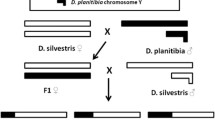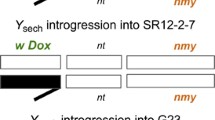Abstract
The Drosophila simulans Lhr rescues lethal hybrids from the cross of D. melanogaster and D. simulans. We describe here, the phenotypes of Lhr dependent rescue hybrids and demonstrate the effects of Lhr on functional morphology of the salivary chromosomes in the hybrids. Our results reveal that the phenotypes of the ‘Lhr dependent rescued’ hybrids were largely dependent on the genetic background and the dominance in species and hybrids, and not on Lhr. Cytological examination reveal that while the salivary chromosome of ‘larval lethal’ male carrying melanogaster X chromosome was unusually thin and contracted, in ‘rescued’ hybrid males (C mel X mel Y sim ; A mel A sim ) the X chromosome showed typical pale staining, enlarged diameter and incorporated higher rate of 3H-uridine in presence of one dose Lhr in the genome. In hybrid males carrying simulans X chromosome (C mel X sim Y mel ; A mel A sim ), enlarged width of the polytene X chromosome was noted in most of the nuclei, in Lhr background, and transcribed at higher rate than that of the single X chromosome of male. In hybrid females (both viable, e.g., C mel X mel X sim ; A mel A sim and rescued, e.g., C mel X mel X mel ; A mel A sim ), the functional morphology of the X chromosomes were comparable to that of diploid autosomes in presence of one dose of Lhr. In hybrid metafemales, (C mel X mel X mel X sim ; A mel A sim ), two dose of melanogaster X chromosomes and one dose of simulans X chromosome were transcribed almost at ‘female’ rate in hybrid genetic background in presence of one dose of Lhr. In rescued hybrid males, the melanogaster-derived X chromosome appeared to complete its replication faster than autosomes. These results together have been interpreted to have suggested that Lhr suppresses the lethality of hybrids by regulating functional activities of the X chromosome(s) for dosage compensation.
Similar content being viewed by others
References
Acharyya M. and Chatterjee R. N. 2002 Genetic analysis of an intersex allele (ix 5) that regulates sexual phenotype of both female and male Drosophila melanogaster. Genet. Res. Camb. 80, 7–14.
Ashburner M. 1989 Drosophila: a laboratory Hand book. Cold Spring Harbor Laboratory Press, New York.
Baker B. S., Gorman M. and Martin I. 1994 Dosage compensation in Drosophila. Annu. Rev. Genet. 28, 491–521.
Barbash D. A., Roote J. and Ashburner M. 2000 The Drosophila melanogaster Hybrid male rescue gene causes inviability in male and female species hybrids. Genetics 154, 1747–1771.
Barbash D. A., Shno D. F., Tarone A. M. and Roote J. 2003 A ripidly evolving MYB-related protein causes species isolation in Drosophila. Proc. Natl. Acad. Sci. USA 100, 5302–5307.
Chatterjee R. N. and Mukherjee A. S. 1977 Chromosomal basis of dosage compensation in Drosophila. IX. Cellular autonomy of the faster replication of X chromosome in haplo X cells of Drosophila melanogaster and synchronous initiation. J. Cell Biol. 74, 168–180.
Chatterjee R. N. and Mukherjee A. S. 1981 Chromosomal basis of dosage compensation in Drosophila X. Assessment of hyperactivity of the male X in situ. J. Cell Sci. 47, 295–309.
Chatterjee R. N. and Ghosh S. 1985 Transcription of the X chromosomes in hybrids of Drosophila melanogaster and D. simulans. Ind. J. Expt. Biol. 23, 293–295.
Civetta A. and Singh R. S. 1998 Sex and speciation: genetic architecture and evolutionary potential of sexual versus nonsexual traits in the sibling species of the Drosophila melanogaster complex. Evolution 52, 1080–1092
Coyne J. A. 1983 Genetics basis of differences in genital morphology among three sibling species of Drosophila. Evolution 37, 1101–1118.
Coyne J. A. and Orr H. A. 1998 The evolutionary genetics of speciation. Phil. Trans. R. Soc. Lond. B. 353, 287–305.
Davis A.W., Noonburg E. G. and Wu C. I. 1994 Evidence for complex genic interactions between conspecific chromosomes underlying hybrid female sterility in the Drosophila simulans clade. Genetics 137, 191–199.
Dobzhansky T. 1940 Speciation as a stage in evolutionary divergence. Am. Nat. 74, 312–321.
Dobzhansky T. 1957 The X chromosome in the larval salivary glands of hybrids Drosophila insularies X Drosophila tropicalis. Chromosoma 8, 691–698.
Hadorn E. 1961 Zur Autonomie und Phasenspezifitat der Latalitat von Bastrarden zwischen Drosophila melanogaster and Drosophila simulans. Rev. Suisse Zool. 68, 197–207.
Hollocher H. and Wu C. I. 1996 The genetics of reproductive isolation in the Drosophila simulans clade: X vs autosomal effects and male vs. female effects. Genetics 143, 1243–1255.
Hutter P. 1997 Genetics of hybrid inviability in Drosophila. Adv. Genet. 36, 157–185.
Hutter P. and Ashburner M. 1987 Genetic rescue of inviable hybrids between Drosophila melanogaster and its sibling species. Nature 327, 331–333.
Hutter P., Roote J. and Ashburner M. 1990 A genetic basis of the inviability of hybrids between sibling species of Drosophila. Genetics, 124, 909–920.
Lakhotia S. C. Mishra A. and Sinha P. 1981 Dosage compensation of X chromosome activity in interspecific hybrids of Drosophila melanogaster and D. simulans. Chromosoma 82, 229–236.
Lee W. H. 1978 Temperature sensitive viability of hybrid between Drosophila melanogaster and D. simulans. Jpn J. Genet. 53, 339–344.
Lindsley D. L. and Zimm G. G. 1992 The genome of Drsosophila melanogaster. Academic Press, New York.
Long A. D. and Singh E. S. 1995 Molecules versus morphology: the detection of selection acting on morphological characters along a cline in Drosophila melanogaster. Heredity 74, 569–581.
Meer B. 1976 Anomalous development and differential DNA replication in the X chromosome of a Drosophila hybrid. Chromosoma 57, 235–260.
Muller H. J. 1940 Bearing of the Drosophila work on systematics pp. 185–268 in The New Systematics. (ed. J. S. Huxley), Clarendon Press, Oxford.
Mutsuddi (NEE’ Das) M., Mutsuddi D., Mukherjee A. S. and Duttagupta A. K. 1984 Conserved autonomy of replication of the X chromosomes in hybrids of Drosophila miranda and D. persimilis. Chromosoma 89, 55–62.
Orr H. A. and Irving S. 2000 Genetic analysis of the Hybrid male rescue locus of Drosophila. Genetics 155, 225–231.
Orr H. A. and Presgraves D. C. 2000 Speciation by post zygotic isolation: forces, genes and molecules. BioEssays 22, 1085–1094.
Orr H. A., Madden L. D., Coyne J. A., Goodwin R. and Hawley R. S. 1997 The develeopmental genetics of hybrid inviability: A mitotic defect in Drosophila hybrids. Genetics 145, 1031–1040.
Presgraves D. C., Balagopalan L., Abmaya S. M. and Orr H. A. 2003 Adaptive evolution drives divergence of a hybrid inviability gene between two species of Drosophila. Nature 420, 715–717.
Raff R. A. and Kauffman T. C. 1983 Embryos, genes and Evolution: The developmental genetics of Evolutionary changes. Collier Macmillan Publishers, London
Sanchez L. and Dubendofer L. 1983 Development of imaginal disks from lethal hybrids between Drosophila melanogaster and Drosophila mauritiana. Roux’s Arch Dev. Biol. 192, 48–50.
Sanchez L. and Santamaria P. 1997 Reproductive isolation and morphogenetic evolution in Drosophila analyzed by breakage of ethological barriers. Genetics 147, 231–242.
Sawamura K. 1999 The origin of reproductive isolation: Biological mechanisms of genetic incompatibility. In “The biology of biodiversity” (ed. M. Kato) pp. 3–19 Springer-Verlag, Tokyo
Sawamura K. and Yamamoto M. T. 1993 Cytogenetic localization of Zygotic hybrid rescue (Zhr), a Drosophila melanogaster gene that rescues interspecific hybrids from embryonic lethality. Molecular General Genetics 239, 441–449.
Sawamura K., Taira T. and Watanabe T. K. 1993a Hybrid lethal systems in the Drosophila melanogaster species complex. I. The maternal hybrid rescue (mhr) gene of Drosophila simulans. Genetics 133, 299–305.
Sawamura K. Yamamoto M. T. and Watanabe T. K. 1993b Hybrid lethal systems in the Drosophila melanogaster species complex II. The Zygotic hybrid rescue (Zhr) gene of Drosophila melanogaster. Genetics 133, 307–313.
Sawamura K., Watanabe T. K. and Yamamoto M. T. 1993c Hybrid lethal systems in the Drosophila melanogaster species complex. Genetica 88, 175–185.
Sawamura K., Roote J., Wu C. I. and Yamamoto M. T. 2004 Genetic complexity underlying hybrid male sterility in Drosophila. Genetics 166, 789–796.
Sturtevant A. H. 1920 Genetic studies on Drosophila simulans I. Introduction. Hybrids with Drosophila melanogaster. Genetics 5, 488–500.
Sturtevant A. H. 1929 The genetics of Drosophila simulans. Carnegie Inst. Washington Publication No. 399, pp. 1–62
Szabad J. 1978 Quick preparation of Drosophila for microscopic analysis. Drosophila Information Service 53, 215.
Takamura T. K. and Watanabe T. K. 1980 Further studies on the Lethal hybrid rescue (Lhr) gene of Drosophila simulans. Jpn. J. Genet. 55, 405–408.
Ting C. T., Tsaur S. C., Wu M. L. and Wu C. I. 1998 A rapidly evolving homeobox at the site of a hybrid sterility gene. Science 282, 1501–1504.
True J. R., Weir. B. S. and Laurie C. C. 1996 A genome wide survey of hybrid incompatibility factors by the introgression of marked segments of Drosophila mauritiana chromosomes into Drosophila simulans. Genetics 142, 819–837.
Watanabe T. K. 1979 A gene that rescues the lethal hybrids between Drosophila melanogaster and D. simulans. Jpn J. Genet. 54, 325–331.
Wu C. I. and Palopoli M. F. 1994 Genetics of post mating reproductive isolation in animals. Annu. Rev. Genet. 27, 283–308.
Author information
Authors and Affiliations
Corresponding author
Rights and permissions
About this article
Cite this article
Chatterjee, R.N., Chatterjee, P., Pal, A. et al. Drosophila simulans Lethal hybrid rescue mutation (Lhr) rescues inviable hybrids by restoring X chromosomal dosage compensation and causes fluctuating asymmetry of development. J Genet 86, 203–215 (2007). https://doi.org/10.1007/s12041-007-0028-5
Received:
Published:
Issue Date:
DOI: https://doi.org/10.1007/s12041-007-0028-5




